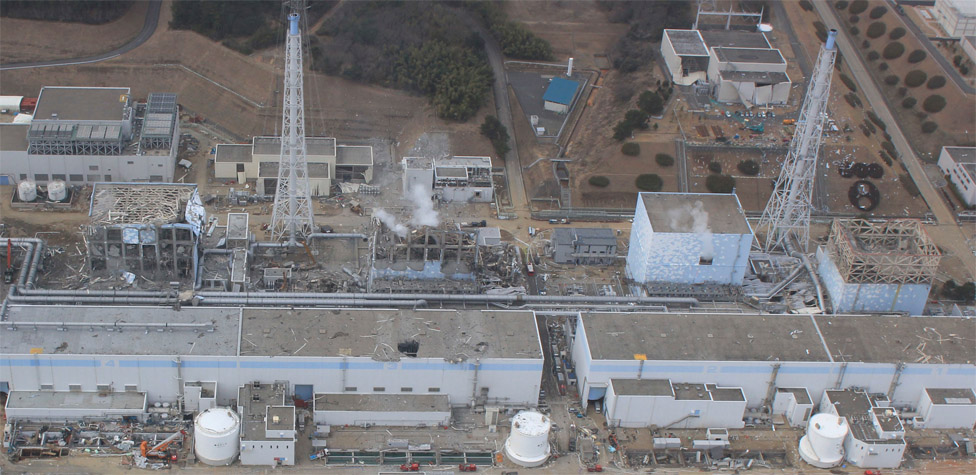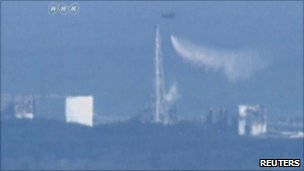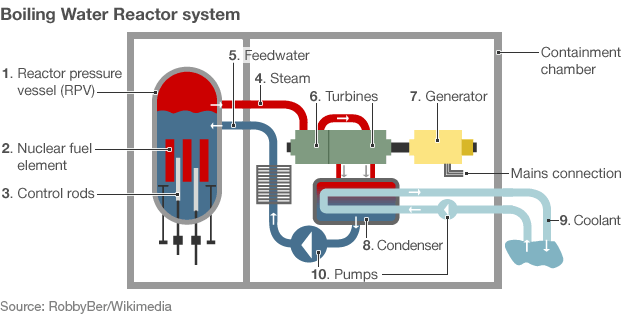cybercore
New Member
- Joined
- Jul 7, 2009
A month has elapsed since the emergency at Fukushima began. But what exactly has gone on there and what are the priorities now?

One way of looking at the drama that has unfolded around the Fukushima Daiichi nuclear reactors is as a narrative with one central plot, and a number of sub-plots distracting the attention.
The main story is well established. At 14:46 local time on 11 March, a magnitude 9 earthquake struck off Japan's north-east coast.
The 11 operating nuclear power reactors in the region all "tripped" as designed (the nuclear fission process was stopped).
However, the fuel in a nuclear reactor continues to produce considerable amounts of heat even when fission has stopped, and the key task - the main plot in this drama - is to keep water circulating over the fuel to remove that decay heat.
This is to prevent damage to the fuel rods, and to the containment around the reactor - the thick steel pressure vessel and the surrounding concrete structure designed to keep fissile material isolated from the outside world in all circumstances.
Mains electric power to the pumps providing this cooling water was lost in the earthquake, so back-up diesel generators kicked in, again as designed, and all looked good. But an hour later the tsunami hit, taking out the diesel generators and the oil storage tanks. Fukushima Daiichi was designed to withstand a six-metre tsunami - 15 metres was just too much.
All the reactors except Daiichi 1-3 were brought into "cold shutdown", with water circulating as required, some after minor problems. But at the three oldest Fukushima plants, connected to the grid between 1970 and 1974, the loss of power to the pumps led to water in the pressure vessel boiling and the fuel heating up hugely.
The zirconium alloy cans that contain the fuel pellets burst and it is probable that some fuel melted, though we cannot yet be sure about this.
Pressure
The early decision to evacuate people from the immediate area was crucial - it gave the operators flexibility to deal with the immediate problem, which was the build-up of pressure inside the pressure vessel as the water boiled.
Too much pressure would burst the seals in the pressure vessel and allow material to escape, so it was necessary to vent these gases.
However, inevitably, letting the steam out also allowed escapes of hydrogen (caused by the zirconium reacting with water or steam at high temperatures) and small amounts of radioactive material which had leaked from the broken fuel rods.
This was the cue for the first subplot - the explosion in the outer buildings of Reactor 1 on the 12 March, followed by a similar explosion in Reactor 3 on 14 March, caused by hydrogen mixing with air.
Dramatic as the pictures were, these explosions did not seem to damage the containment. On the other hand, an explosive noise from within Reactor 2 on 15 March led to fears that there might be a breach in part of the containment, known as the suppression chamber or "torus" - again, we still do not know for sure.
By now, with no power available on site, the water level inside Reactors 1 to 3 was sinking and the fuel was seriously overheating.

Fresh water supplies ran out, so a decision was taken to switch to seawater, and to inject it from fire trucks through a fire extinguishing line. Later, a new supply of fresh water became available from a local dam, and this is now being used, as salt deposits from the seawater risked jamming up valves and causing other damage in the cores.
This operation is continuing, with estimates suggesting that water levels are now above half-way up the fuel in the core of Reactors 1-3, enough to introduce an element of stability while work continues to restore mains power to the cooling system pumps.
Fuel ponds
Power is back to the plant as a whole, but these pumps have not yet been switched on. It is also likely that many of them will need replacing because of damage suffered during the tsunami.
The second subplot centres on the spent fuel ponds, where fuel that has been taken out of the reactor is cooled for some months until it is taken away for processing. The water supply to these ponds - to replace water lost through evaporation - was interrupted, resulting in boiling.
At Reactor 4, where there was an unusually large amount of spent fuel in the pond, there seems to have been damage to the zirconium fuel rods, and, possibly, a release of hydrogen - there was at any rate another explosion, which damaged the outer building.
It was now necessary to get water into those ponds to prevent major releases of radioactivity, hence the extraordinary sight of a helicopter dropping water from the air and high pressure hoses being directed as best as could be towards the ponds through the wrecked outer buildings.
Water is now being supplied through specialised high-reach pumps normally used for injecting concrete, and via internal plumbing.
Then came the leak of highly contaminated water from a service pit near Reactor 2, resulting in discharges to the sea. A 20cm crack was detected and sealed using a polymer called "water glass", though where the contamination came from in the first place remains unclear.
And in yet another subplot, waste water reservoirs on site became full of lightly contaminated water, leaving no space for more heavily contaminated water - requiring a further (light) release into the sea.
Traces of plutonium - which may have originated in the spent fuel ponds of Reactor 4 - were also detected in soil at the site.
Temperature
These subplots, though not really going anywhere in themselves, have on a number of occasions made it necessary to take resources away from the main task - the cooling of the reactors - either because of a need to deal with them directly or to avoid high worker doses while associated spikes in radiation levels passed.
The top priority is to get the pumps working that will keep the cores of Reactors 1-3 cool, as the fuel continues to produce decay heat. Success could be defined as cold shutdown - bringing the temperature down below boiling point (100C).
At present, the water temperature inside the reactors is unknown, but temperatures on the outer surface of the pressure vessels range from 84C to 222C.
Beyond that it is important to restore a reliable water supply to the spent fuel ponds, or to remove the spent fuel to another facility, and to make sure that any cracks or other breaches of masonry are blocked to minimise further releases into the environment.
In the long term, a decision could be taken to remove the fuel from the cores of Reactors 1-3, as at Three Mile Island in the US.
So far the amounts of radioactive materials released from the site are very unlikely to cause any detectable long-term health problems - though there will need to be a careful study of contamination in the area.
In the meantime, further subplots would not be helpful.

Via BBC News - Fukushima: What happened - and what needs to be done

One way of looking at the drama that has unfolded around the Fukushima Daiichi nuclear reactors is as a narrative with one central plot, and a number of sub-plots distracting the attention.
The main story is well established. At 14:46 local time on 11 March, a magnitude 9 earthquake struck off Japan's north-east coast.
The 11 operating nuclear power reactors in the region all "tripped" as designed (the nuclear fission process was stopped).
However, the fuel in a nuclear reactor continues to produce considerable amounts of heat even when fission has stopped, and the key task - the main plot in this drama - is to keep water circulating over the fuel to remove that decay heat.
This is to prevent damage to the fuel rods, and to the containment around the reactor - the thick steel pressure vessel and the surrounding concrete structure designed to keep fissile material isolated from the outside world in all circumstances.
Mains electric power to the pumps providing this cooling water was lost in the earthquake, so back-up diesel generators kicked in, again as designed, and all looked good. But an hour later the tsunami hit, taking out the diesel generators and the oil storage tanks. Fukushima Daiichi was designed to withstand a six-metre tsunami - 15 metres was just too much.
All the reactors except Daiichi 1-3 were brought into "cold shutdown", with water circulating as required, some after minor problems. But at the three oldest Fukushima plants, connected to the grid between 1970 and 1974, the loss of power to the pumps led to water in the pressure vessel boiling and the fuel heating up hugely.
The zirconium alloy cans that contain the fuel pellets burst and it is probable that some fuel melted, though we cannot yet be sure about this.
Pressure
The early decision to evacuate people from the immediate area was crucial - it gave the operators flexibility to deal with the immediate problem, which was the build-up of pressure inside the pressure vessel as the water boiled.
Too much pressure would burst the seals in the pressure vessel and allow material to escape, so it was necessary to vent these gases.
However, inevitably, letting the steam out also allowed escapes of hydrogen (caused by the zirconium reacting with water or steam at high temperatures) and small amounts of radioactive material which had leaked from the broken fuel rods.
This was the cue for the first subplot - the explosion in the outer buildings of Reactor 1 on the 12 March, followed by a similar explosion in Reactor 3 on 14 March, caused by hydrogen mixing with air.
Dramatic as the pictures were, these explosions did not seem to damage the containment. On the other hand, an explosive noise from within Reactor 2 on 15 March led to fears that there might be a breach in part of the containment, known as the suppression chamber or "torus" - again, we still do not know for sure.
By now, with no power available on site, the water level inside Reactors 1 to 3 was sinking and the fuel was seriously overheating.

Fresh water supplies ran out, so a decision was taken to switch to seawater, and to inject it from fire trucks through a fire extinguishing line. Later, a new supply of fresh water became available from a local dam, and this is now being used, as salt deposits from the seawater risked jamming up valves and causing other damage in the cores.
This operation is continuing, with estimates suggesting that water levels are now above half-way up the fuel in the core of Reactors 1-3, enough to introduce an element of stability while work continues to restore mains power to the cooling system pumps.
Fuel ponds
Power is back to the plant as a whole, but these pumps have not yet been switched on. It is also likely that many of them will need replacing because of damage suffered during the tsunami.
The second subplot centres on the spent fuel ponds, where fuel that has been taken out of the reactor is cooled for some months until it is taken away for processing. The water supply to these ponds - to replace water lost through evaporation - was interrupted, resulting in boiling.
At Reactor 4, where there was an unusually large amount of spent fuel in the pond, there seems to have been damage to the zirconium fuel rods, and, possibly, a release of hydrogen - there was at any rate another explosion, which damaged the outer building.
It was now necessary to get water into those ponds to prevent major releases of radioactivity, hence the extraordinary sight of a helicopter dropping water from the air and high pressure hoses being directed as best as could be towards the ponds through the wrecked outer buildings.
Water is now being supplied through specialised high-reach pumps normally used for injecting concrete, and via internal plumbing.
Then came the leak of highly contaminated water from a service pit near Reactor 2, resulting in discharges to the sea. A 20cm crack was detected and sealed using a polymer called "water glass", though where the contamination came from in the first place remains unclear.
And in yet another subplot, waste water reservoirs on site became full of lightly contaminated water, leaving no space for more heavily contaminated water - requiring a further (light) release into the sea.
Traces of plutonium - which may have originated in the spent fuel ponds of Reactor 4 - were also detected in soil at the site.
Temperature
These subplots, though not really going anywhere in themselves, have on a number of occasions made it necessary to take resources away from the main task - the cooling of the reactors - either because of a need to deal with them directly or to avoid high worker doses while associated spikes in radiation levels passed.
The top priority is to get the pumps working that will keep the cores of Reactors 1-3 cool, as the fuel continues to produce decay heat. Success could be defined as cold shutdown - bringing the temperature down below boiling point (100C).
At present, the water temperature inside the reactors is unknown, but temperatures on the outer surface of the pressure vessels range from 84C to 222C.
Beyond that it is important to restore a reliable water supply to the spent fuel ponds, or to remove the spent fuel to another facility, and to make sure that any cracks or other breaches of masonry are blocked to minimise further releases into the environment.
In the long term, a decision could be taken to remove the fuel from the cores of Reactors 1-3, as at Three Mile Island in the US.
So far the amounts of radioactive materials released from the site are very unlikely to cause any detectable long-term health problems - though there will need to be a careful study of contamination in the area.
In the meantime, further subplots would not be helpful.

Via BBC News - Fukushima: What happened - and what needs to be done